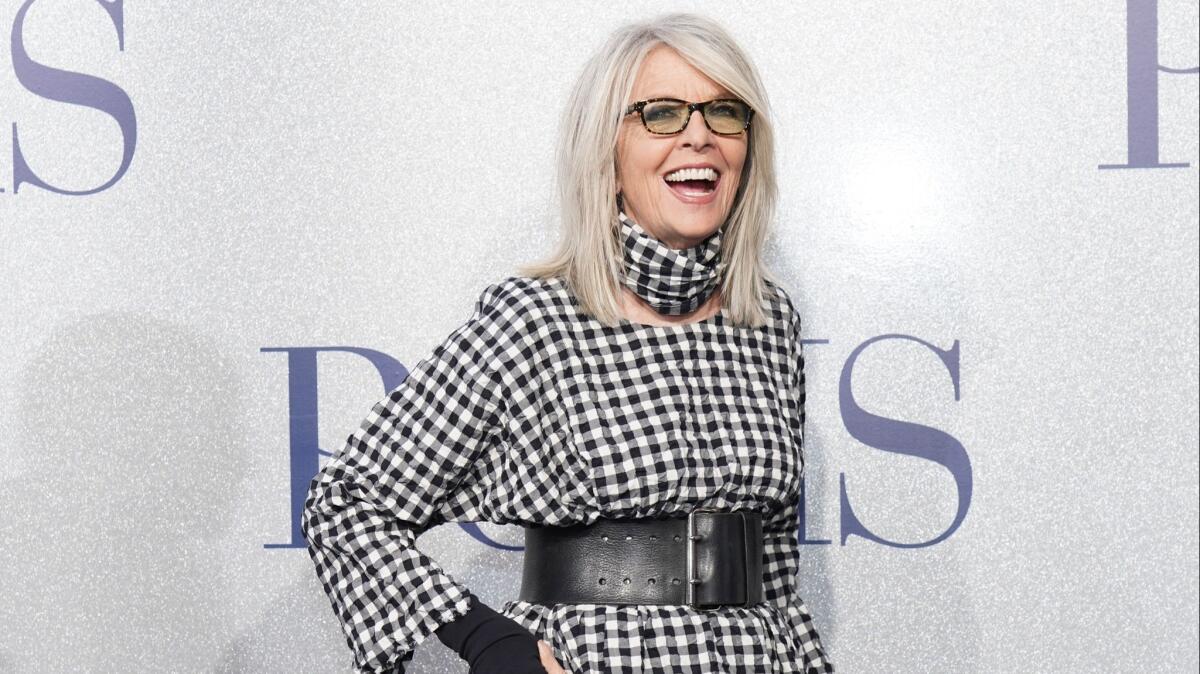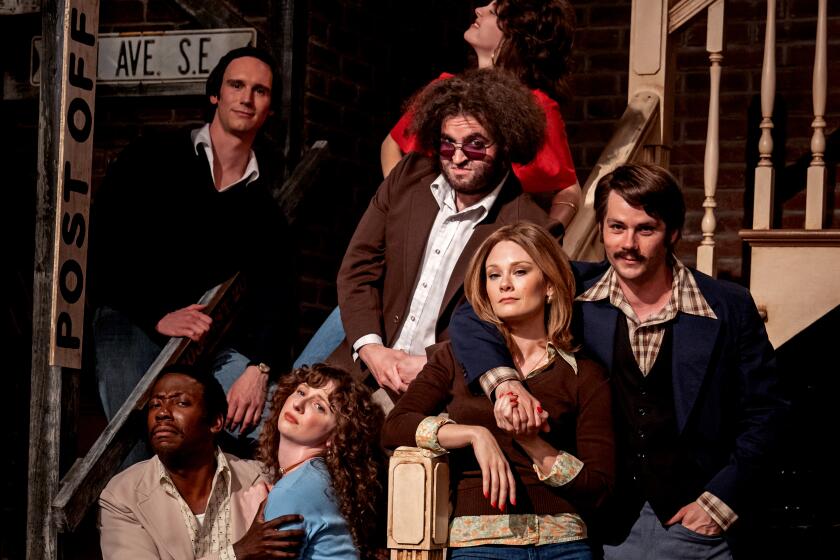Why Diane Keaton cares more about Instagram than Hollywood
Diane Keaton doesn’t really track the box office of the films she’s in anymore. The numbers she’s obsessed with are on Instagram.
“Instagram. Here’s the problem. Let me just tell you what the problem is,” she says, speaking excitedly. “It’s about checking in to see how many people liked it or are following you. It becomes a problem.”
At age 73 — alongside the likes of ad-sponsored millennials like Chiara Ferragni and Aimee Song — Keaton has become an Instagram fashion influencer. She has 920,000 followers, but wants 1 million. She’s been on the platform since 2015. At first, she used it like Pinterest, sharing her favorite sepia-toned images of dilapidated barns, her golden retriever or a young Matt Dillon.
In December, she started posting photos of her outfits. Oft-menswear inspired, of course, and almost always black or white. Wide-brimmed hats by Nick Fouquet. A Comme des Garçons skort. A pair of Maison Margiela denim gauchos that she received “MORE COMPLIMENTS ON [THAN] ANYTHING I’VE EVER WORN IN MY ENTIRE LIFE.” (All of Keaton’s captions are written in capital letters, not because she wants to convey enthusiasm, but because she finds all-caps more aesthetically pleasing.)
And at the same time as her feed has reasserted her cultural relevance — inspiring headlines in Vogue and InStyle — Keaton has been starring in movies that examine how isolating it can be to be a septuagenarian. In her latest, “Poms,” she plays a woman who starts a cheerleading squad at her retirement home in a quest to find meaning after being diagnosed with cancer. The film, out Friday, follows last year’s “Book Club,” in which her character’s daughters are so worried about their mother living alone in L.A. that they try to force her to move to their community in Arizona.
It can be difficult to see Keaton in these roles, given the reality of her life. She is an active patron of the arts, recently turning up at an L.A. County meeting alongside Brad Pitt to endorse the Los Angeles County Museum of Art’s $650-million redesign. She frequently travels to Las Vegas liquor stores to promote her wine, the Keaton, signing bottles for fans. Last year, she purchased an 1880s-era adobe house in the Barrio Viejo neighborhood of Tucson, Ariz., that she’s now renovating.
And then, of course, there’s Instagram, where A-listers like Kate Hudson, Nancy Meyers and Michelle Pfeiffer follow her every move. “I FEEL THAT I NEED TO BE IN THAT CLOSET WITH YOU,” Gwyneth Paltrow commented on one of her posts last month. Keaton responded by telling Paltrow to “come over any time!,” even though she doesn’t actually know her IRL. (“Right near where I live, she has a store. Goop. Amazing, wouldn’t you say? It’s pretty astonishing. She’s been great online. Probably we will see each other at some point. But I’m really impressed by her skills and her visuals in that Goop. I mean, hello?”)
Despite it all, though — usually when she’s trying to fall asleep, or when she’s at the start of a new day — Keaton has been quietly contemplating her mortality.
“Of course, you think about it. How can you not?” she says. “I mean, I’m 73. How long do you live? It’s really important what those years are like. Those years from 73 to what, you know? A lot of people get sick, a lot of people don’t make it. It’s harder to reach out as you get older. I think that people don’t really consort with older people as much, or embrace them, because it’s a different time of life.”
Not surprisingly, Keaton is still very interested in working. When she was invited to meet with documentary filmmaker Zara Hayes, who also directed “Poms,” she says that “of course” she went, because she is no longer as in-demand as she once was. Hayes surmises that that may just be Keaton’s modesty at play, noting that she knows of at least three recent projects that were sent to the actress’ team and that “got a flat-out ‘no.’”
“People are scared of her,” Hayes says, wondering aloud why her star may be approached less often by Hollywood types. “She doesn’t internalize the idea of herself as an icon, which is what makes her so endearing and real. She wants to email you and for you to email her back. She doesn’t have all of these layers of people around her.”
Indeed, Keaton does not employ a formal publicist, using her assistant to field press requests. And she obviously serves as her own stylist. Sitting for an interview earlier this month, she’d chosen a signature black turtleneck with sleeves that grazed her knuckles underneath a white coat cinched with a big leather belt. She had chunky silver rings on almost every finger, and her gray hair had been immaculately blown out.
“I know what I am by now,” she says. “I know how old I am. I know what my limitations are and what I can and can’t do. So if something appeals to me, I’m definitely going to go for it.”
Still, her feelings about acting remain complicated. She says she sometimes worries that audiences have grown tired of her, joking: “Well, I mean, really, how much can you take? If you’re the audience member, how much of that person can you take?” And despite her Oscar and two Golden Globes, she repeatedly insists that she is not a “professional” actress. She says that she is difficult to edit because she has continuity issues, that she’s unable to do something exactly the same way twice. She recalls going to see Jessica Lange in a 1992 Broadway production of “A Streetcar Named Desire” and being perplexed by the drive her peer expressed for the craft.
“She’d be onstage and she’d be crying — crying real tears onstage. OK?” Keaton says. “So I went back to see her and I said, ‘Oh, God, I don’t know how you do this. I mean, how do you do this?’ [She said,] ‘I love it so much.’ I’m going, ‘You do?’ Not me. You couldn’t get me to do that day after day. I don’t want to do it day after day. Not only do I want to do something different, I don’t want to go there day after day and do the same thing and feel those feelings like that. She’s an actress. It’s like Glenn Close. I mean, these people are really actresses.”
One of Keaton’s costars in “Poms,” Jacki Weaver, laughs at this notion. “She thinks she’s a performer,” Weaver says with a knowing smile. “I think she’s a wonderful actor. I never had a moment with Diane where she wasn’t being truthful and authentic. She just might have a different way of getting there.”
On set, Hayes says Keaton was constantly insisting: “I’m not Meryl Streep, Zara.”
“We all see ourselves in a certain way, and that might not be how the world sees us,” the director says. “I think it’s private for her. She definitely has a way that she works. I think her need is to be in the moment. Every actor needs that, but I think she needs that even more — to not be in her head. I think anything that over-intellectualizes the process is like death to her.”
In recent years, Keaton has increasingly begun to work with female directors, namely Meyers, whom she credits with “saving [her] film life” when she cast her in 2003’s “Something’s Gotta Give” (which earned her a fourth Oscar nomination for lead actress). Still, in 2011, she wrote in her memoir, “Then Again,” that in her career she has sometimes felt that “without a great man writing and directing for me, I was a mediocre movie star at best.”
“Maybe I didn’t think about what I was saying, because that’s not fair,” she says now, reflecting on the line. And yet, when looking for projects, she says that she does not seek female collaborators “more than anyone else” and that she has not experienced a difference in working with women versus men on set.
Keaton faced criticism for not supporting women as she remained a steadfast defender of her longtime friend and “Annie Hall” director Woody Allen. When child sex allegations made by Allen’s adopted daughter Dylan Farrow resurfaced in the wake of the #MeToo scandal, Keaton tweeted in January 2018: “Woody Allen is my friend and I continue to believe him.”
Today, she refuses to address the situation further.
“I don’t talk about it all,” she says, starting to fidget in her seat. “I think I’ve said what I have to say about Woody and his situation.”
In fact, she seems wary of entering into any further public disputes. She refuses to clap back at Anjelica Huston, who this month made a not-so-veiled jab at Keaton in an interview when she said she wanted to do movies “that aren’t apologetically humble or humiliating, like ‘band of cheerleaders gets back together for one last hurrah.’”
“Maybe she doesn’t like light — well, maybe she thinks a movie like — I don’t know. It’s too cute?” Keaton says, searching for the right words. “Oh well, whatever. I mean, please. It’s fine. What do I expect? I mean, you know, hey. Everybody’s entitled to how they feel about certain kinds of things. Maybe she doesn’t like that kind of genre.”
Keaton feels proud of “Poms,” though, especially because it raises issues about loneliness in older age. It’s something she’s been thinking about a lot since her brother, Randy, two years her junior, was diagnosed with dementia. He stays at a Sunrise living facility in Culver City, where Keaton visits him every Sunday. “Poms” was also shot at a Sunrise facility — this one outside Atlanta — and so Randy was often called to mind.
“Look, being older is being rejected much more than when you’re a younger age,” she says. “Even in your 60s, you can get by with people taking you seriously. But everybody’s afraid to be old. Because what it means is they’re too gonna die. The reminder of it is unpleasant, and the appearance of it is unpleasant for a lot of people. It’s like a homeless person. You’re frequently seen as a toss-away.”
Keaton acknowledges that she has not been treated that way, calling herself “lucky” because she has earned money and can sustain her lifestyle. Acting is still primarily how she makes her living, but her interest is more in her hobbies these days. If she had enough money, she says, she’d like to buy old factory buildings, “maybe do them up better and sell them. Take care of them.
“It’s up to you to make something of it yourself,” she says of older age. “I mean, what about retirement? To me, when people talk about retirement, it just seems like, ‘What? Don’t do that.’ You can get lost without the patterns of your life. It’s about opening up new patterns.”

Follow me on Twitter @AmyKinLA
More to Read
Only good movies
Get the Indie Focus newsletter, Mark Olsen's weekly guide to the world of cinema.
You may occasionally receive promotional content from the Los Angeles Times.











